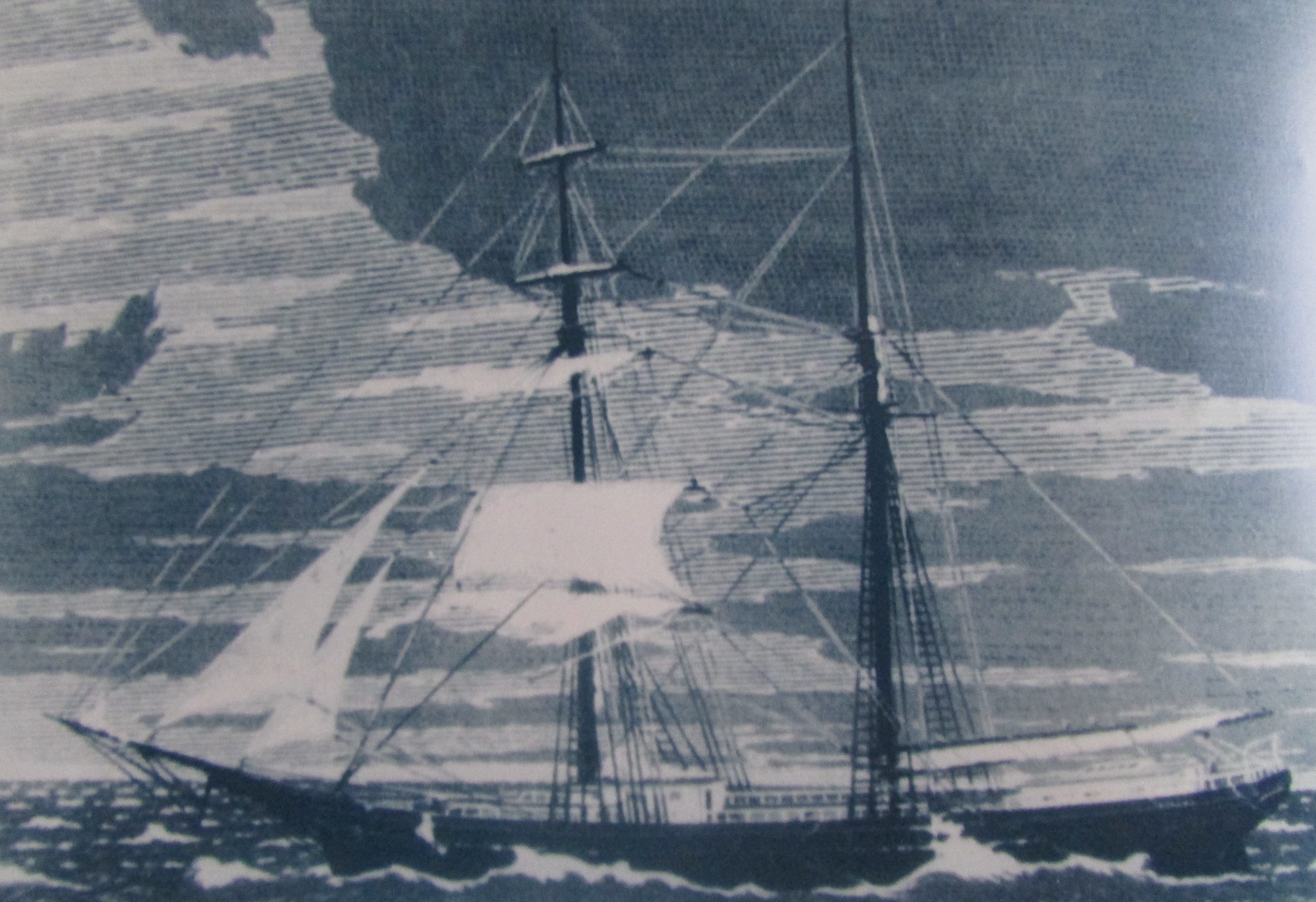Sailing With Good Spirits
Published 10:00 am Sunday, October 1, 2023
|
Getting your Trinity Audio player ready...
|
We have explored many haunted houses together but in the following weeks, we are changing our focus and will delve deep into the world of other haunted areas like ships, fields and jails. I thought we could start with two ships that are from very different eras but are home to quite a few ghosts: the “Mary Celeste” and the “Queen Mary”. For sure you will want to be on dry land and have an adult beverage in hand.
The “Mary Celeste” is one of the most famous of ghost ships. Her legend is full of intrigue that fires the imagination. Perhaps, it is because a baby girl, her two brothers and their momma died tragically while aboard. Perhaps, it is because no one survived to tell the true story. Or maybe, it is because there just did not seem to be a plausible reason for what had happened. The “Mary Celeste” was a sea worthy ship. She began her life in 1862. Built in Nova Scotia, her registry was Canadian and her original name was “Amazon”.
Before her tragedy, nothing unusual happened. Apart from running aground off Cape Breton, seven years after her launching, she was typical of the thousands of small sailing ships during her time. Nothing was found in her career before she set sail for Europe, on the voyage which ended in mystery and misery.
After she had run aground, the “Amazon”, was sold to three New York businessmen. She did need extensive repairs, which the new owners did and then renamed her, “Mary Celeste”.
The captain on the ill-fated voyage was Benjamin Briggs. He was an experienced seaman, having commanded several vessels before the “Mary Celeste”. He was also the son of a sea captain and felt at home on board a sailing ship.
His wife, Sarah, and infant daughter, Sophia, as well as his two boys, went along on this voyage. It was not unusual, at this time, for wives and families to accompany the captains of sailing ships because they were gone for a very long time.
Also, Captain Briggs had bought an interest in the “Mary Celeste”. This, too, was a common practice for captains of this time. No doubt, he thought this would help provide a secure future for his family.
According to the ships log, Captain Briggs had overseen the loading of a cargo of 1,700 barrels of American alcohol, bound for clients in Genoa, Italy. The cargo was not a temptation to Briggs who was devoutly religious and a firm non drinker. Also, the crew was made up of experienced, hand-picked men, none of which would have tampered with the cargo.
However, Captain Briggs was a very careful man and from the very beginning he worried about fumes from the alcohol circulating throughout the ship. Also, there were stories of explosions and with his wife and children on board, he was taking no chances. Several times during the voyage, he checked the barrels to be sure that they were intact and tightly sealed.
The ”Mary Celeste” set sail from New York on November 7, 1872. Right from the very start, things just didn’t go right. At first, the winds were against the ship and Briggs had to anchor out in New York Harbor to wait for the wind to change.
Finally, early the next morning, the wind cooperated and the ship set sail. However, after about a half a day at sea, high winds came up and the Atlantic became very rough. Their destination was the Azores, a very long, two thousand miles ahead.
As the waves crashed over the bow of the ship, Captain Briggs took over the helm. He had been in rough waters before and he also had a seasoned crew so he was confident he would reach his destination. Halfway to the Azores, Briggs checked the ships heading and she was right on course.
However, the fabled Witch of November, struck again. Captain Briggs thought that once they crossed into warmer waters, the seas would settle down but this didn’t happen. The Atlantic Ocean was still a boiling caldron. Next, Briggs discovered that several of the barrels of alcohol were leaking into the bilge. On November 23rd, he then discovered leaks in the ship’s hull. However, at this time the pumps were handling the problem.
A couple of days later, Briggs discovered that the ship was off course and they were passing to the north of St. Mary’s Island, not south. This was a dangerous area because of the many shallow reefs.
Also at this time, he wrote in the ship’s log, that everyone on board had symptoms of alcohol poisoning. While he was writing, the wooden hull of the ship crashed onto the rocks of one of many reefs and mayhem ensued.
The “Mary Celeste” was not going to be able to stay afloat because the pumps were not keeping up and abandoning ship was necessary. However, given the condition of the sea, this, too, was very dangerous. Captain Briggs had a life-or-death decision to make. He chose getting everyone into the life boats.
After ten days adrift, everyone was dying. Sarah, and baby Sophia, died first. The two boys were next. Captain Briggs had lost his whole family. Now, with a broken heart, he pushed himself over the side of the boat. Within two hours, the rest of the crew were also dead. This would have been around December 7th.
On December 14th, the sailing ship, “Del Gratia”, under the command of Captain Moorehouse, spotted the “Mary Celeste” drifting erratically out at sea. Moorehouse ordered his first mate, Deveau, to take some crew members and board her. This is when they discovered she was a derelict.
Some stories say that they found half eaten meals, which were still warm and clocks set to run backwards. However, here is what is known of the facts. When the incident was investigated, it was discovered that the vessel was sea worthy. However, she did have damage to her hull. The hatch door on the foredeck was missing and this would have allowed sea water to enter into the ship during rough waters.
Everyone felt that Captain Briggs and his crew abandoned ship in a hurry as they left supplies behind. They also left the ship’s log and some other papers which told about the ship’s condition and that of the cargo. However, Briggs had taken the chronometer and sextant into the lifeboat with him. The last entry in the log read just the date: November 25th. This was twenty days before the “Mary Celeste” was discovered.
Captain Briggs must have felt that they were sinking and gave the order to abandon ship. There were deep ax cuts in the hatch cover, where the lifeboat would have been secured. This indicated that the crew must have had to use an ax to cut it loose, rather than waste precious minutes unlashing it.
The ultimate end came to the “Mary Celeste” about twelve years after her abandonment. During those years, she was owned by many companies and sailed from many ports. Her final passage was from New York to Port au Prince in Haiti.
On January 3, 1885, she was sailing through a narrow channel between the southern end of Haiti and Gonave Island. The sky was blue and the seas were calm. However, barely rising out of the water, in the middle of the channel, was Rochlelais Reef, a rocky mountain of coral. It was plainly marked on the charts and was visible to the helmsman. But, when the helmsman went to turn the wheel to avoid the reef, the captain ordered him not to, but to head straight for the reef.
The “Mary Celeste” hit this obstruction dead center. Her keel and planking were gouged through by the coral, whose sharp spines cut through the upper sheathing on the bottom and ripped into the bowels of the ship. Her bow then drove up and over the reef, as her stern sunk beneath the water. After she groaned in pain, she was silent.
A board of inquiry discovered that the captain was involved in an insurance scam for she was very over insured. On her manifest it said, she had a very valuable cargo, which in fact was fish and rubber shoes.
The wreck of the “Mary Celeste” has disappeared through time as she has become encased in coral, covering her in a thick spiny tomb, on the barren reef, near Haiti. Some think that she was haunted by Captain Briggs who wanted the ship to sink on the reef.
Of the famous haunted ships, the “RMS Queen Mary” is the most iconic of them all. She embarked on her maiden voyage in May, 1936, steaming her way from Southampton, England, to New York City, in a little more than five days. Two years later, she set a record for the fastest Atlantic crossing which stood until 1952. She set other records, too, until her retirement in 1967.
She first received her sea legs, as the flagship of a top British shipping line. Back then, she was the fastest, most luxurious, and just a few feet short of being the largest ship to cross the Atlantic. Her first-class accommodations were used by many celebrities. Though this was the time of the Depression, she represented elegant travel. The only event that stopped her was the outbreak of World War II, in 1939.
Now, the “Queen Mary” was called into service for another reason, to be a transport ship for Allied troops. Six miles of carpet, 220 cases of china, crystal, and silver service along with tapestries and paintings were removed and stored in warehouses for the duration of the War.
Her passenger capacity was doubled from 2,500 to 5,000 which eventually became 10,000. She received a stealth paint job that earned her the nickname, “Grey Ghost”. During the course of the War, she ferried over 800,000 troops to Europe. She even set the record for most folks aboard a floating vessel by carrying 16,683 passengers at one time!
During the War, she began making trips all over the world, mostly from Southampton to Sydney. It was during this time, that the “Queen Mary” became involved in a maritime tragedy while crossing the Atlantic.
It was October of 1942, the “Queen Mary” was zigzagging back and forth, as she crossed the Atlantic, performing the maneuver that was used to confuse any enemy submarines which may be in the area. This is when the mammoth ship slammed into her escort cruiser, “HMS Curacao”. She sliced through the smaller, boat, cutting it in half and causing over 300 sailors to fall overboard to their death in the icy water. The screams of the dying rang across the water, but by military rule, the “Queen Mary” couldn’t go back to rescue them. In less than 6 minutes the waters grew silent. The “Queen Mary” received minor damages but the escort ship was gone.
In 1947, the “Queen Mary” returned to her former civilian life and once again became a luxury liner. For the next 20 years, she was very popular but then along came the jet airplane. She was then retired in 1967, and permanently moored in the city of Long Beach, California, where she was converted into a floating hotel and tourist attraction, in 1971.
This is when the stories of strange sightings and sounds began surfacing. She now earned the reputation as one of the most haunted ships/hotels in America. There were so many happenings on board that provided reasons for the hauntings. During her life at sea, at least a dozen of her crew members and more than three dozen passengers, died onboard.
One popular spirit was that of 2nd Officer W. E. Stark, who died one night in 1949, after accidentally drinking acid instead of gin. He is mostly seen staggering through the ship’s corridors.
In the dining room, there were numerous reports of ghosts, most notably, the Woman in White, who glides across the ballroom, dancing and singing, totally unaware of her surroundings.
There is also a haunting in the cargo hold by a woman in a red dress, who keeps descending the stairs. An odd place for a woman passenger to be, it is believed that she was meeting someone when she fell to the metal floor below.
Also, deep in the belly of the ship, where there is the endless clanking and banging from the engines, an 18-year-old sailor named, John Pedder, mistakenly tried to slip through a thick, heavy watertight door, #13, and was crushed and cut in half during a practice fire drill in 1966.
Of all of the 12 decks on the “Queen Mary”, B Deck is known as the most haunted, and particularly Room B-340. Everyone who ever stayed in this room reported strange noises, ghostly footsteps and peculiar plumbing problems like faucets turning on and off and toilets flushing by themselves. There were also reports by the cleaning staff of beds being torn apart when no one was staying in the room and sounds of a baby crying. The room is no longer available to the public as it had to be shut down.
Perhaps the scariest of the hauntings takes place in the area of the “Queen Mary’s” bow, where she collied with the “Curacao”. This takes the form of noises that sound like crashing and grinding, the kind that would be heard when there is metal upon metal, smashing into each other. Also, the sounds of moaning and words of prayer.
Even after she had been docked for more than 40 years, these noises were still heard. One particular day in 1989, a ship’s carpenter, John Smith, while working below decks in the bow of the ship, where it had cut through the side of the “Curacao”, he reported hearing voices and the sound of water rushing in. Smith said he did not know about the wartime accident when he first heard these noises.
Many paranormal groups have investigated the “Queen Mary” and all agree she is definitely haunted.






